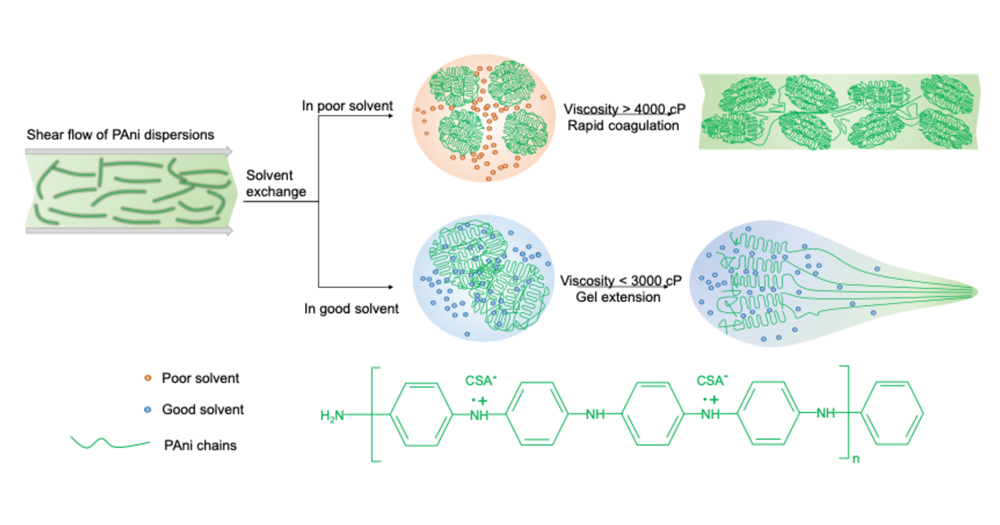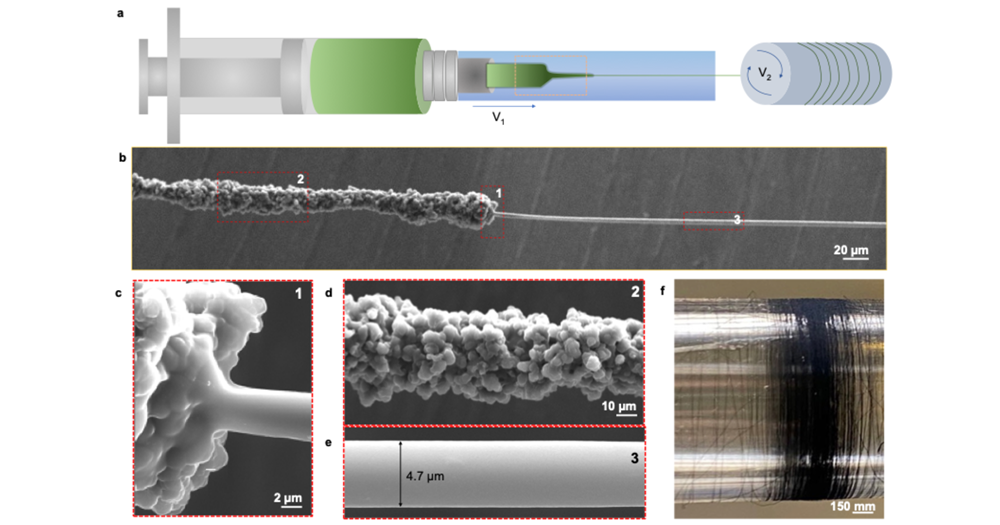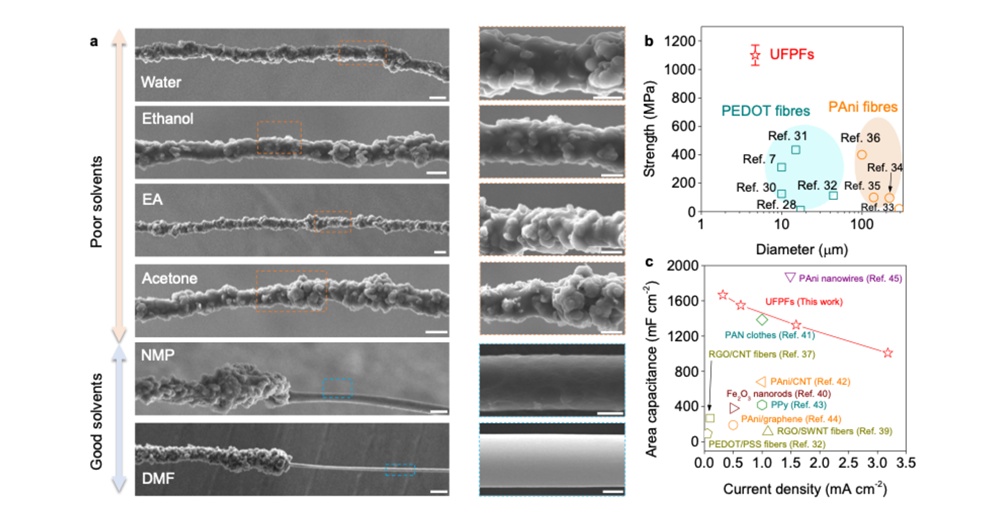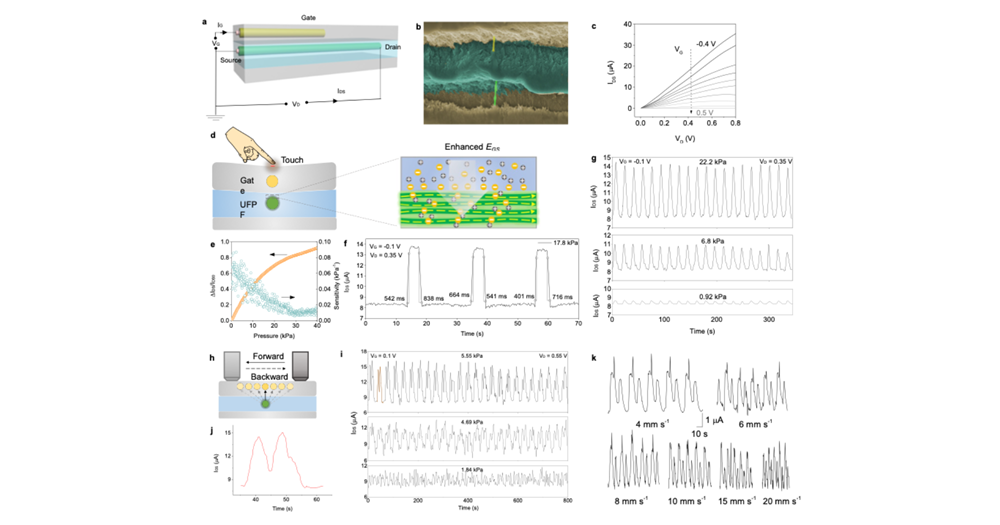High performance conducting polymer fibres are in high demand in applications that range from advanced fibrous devices to frontier fabric electronics. Recently, a joint research team led by Prof. Tao Xiaoming and Dr Chai Yang reported a scalable good solvent exchange strategy to produce ultrafine polyaniline (PAni) fibres. This work is published in Nature Communications. The first and second authors are Dr Fang Bo and Mr Jianmin An (https://www.nature.com/articles/s41467-022-29773-9).
The extended conjugated and easily doped π-system along the backbone enables conducting polymers to possess intriguing transport, optical, and electrochemical properties, which have been rarely found in conventional polymers and metal conductors. Processing conducting polymers into macroscopically fibrous materials makes it possible to translate their nano-object features to human-friendly products in a continuous manner. Primarily due to the large diameters, the performance and expectations of most achieved continuous conducting polymer fibres (CPFs) have been limited by their insufficient electroactive surface and weak tensile strength. In conventional wet spinning processes, conducting polymer dopes give rise to transient solidification in poor solvents, induced by the strong interactions of conducting polymer chains. The rapidly hardened gels suppress the post-stretching and slenderising procedures, and cause the wet-spun CPFs to show a large diameter, generally beyond 10 µm. The large diameters largely discount the mechanical properties and electrochemical activities of CPFs. As shown in Figure 1, Prof. Tao’s group report a good solvent exchange strategy in a modified wet spinning technique to prepare ultrafine PAni fibres (UFPFs) at a large scale. Beyond the conventional wet spinning protocol, they replaced poor solvents with good solvents as the coagulation bath to decrease the viscosity of the gel protofibres, which were subject to an ultrahigh drawing ratio and reduced to an ultrafine morphology.
In the modified one-step wet spinning process, Prof. Tao and her research group used good solvents as the coagulation bath to realise the mass production of the UFPFs (Figure 2a). After doping PAni powder (emeraldine base) with camphor sulfonic acid (CSA), they dispersed fully doped PAni into m-cresol as the raw spinning dopes. Significantly, the direct use of doped PAni solutions as the dopes saves the trouble of utilising conventional post-doping procedures, and further permits a uniform charge distribution throughout the fibre length. A good solvent, dimethyl formamide (DMF), of PAni was used as the coagulation bath. A slow solvent exchange between m-cresol and DMF facilitated the formation of PAni gel protofibres with quite a low viscosity that is below 3000 cP. Subsequently, a sharp decrease in the diameter from ~0.1 mm to ~4.7 µm was observed when stretching the gel fibres in the bath (Figures 2b-2e), which is a record small value in the achieved wet-spun CPFs. The ultrafine fibre shows a smooth surface, highly crystallized microstructure, and uniform electrical properties. Moreover, such an impressive drawing ratio enables a very high production efficiency of UFPFs beyond 40 metres per minute. For example, they prepared a 5.4-kilometre-long UFPF in two hours (Figure 2f).
The sharp necking behaviours of the gel protofibres are highly related to the use of good solvents as the coagulation bath. Prof. Tao and her research team recorded the changes in the surface morphology of the PAni fibres collected from different solvating species. As shown in Figure 3a, the obtained fibres in poor solvating species, i.e., water, ethanol, ethyl acetate (EA), and acetone, generally show a coarse surface and large diameter of around 20 µm. By comparison, a necking phenomenon in both cases of good solvents can be clearly observed; i.e., N-methyl-2-pyrrolidone (NMP) and DMF. Such necking effects promote the ultrafine morphology of the resultant fibres, which contributes to the higher degree of orientation and crystallisation of the PAni fibres, and a better structure and performance stability.
The UFPFs show an impressive mechanical performance and energy storage ability. Derived from the strain-stress curves, the UFPFs have a modulus of 29.89±5.6 GPa, and a strength of 1080±71 MPa, which is at least one order of magnitude higher than that of CPFs with larger diameters (Figure 3b). Prof. Tao and her team used polyvinyl alcohol (PVA)-H3PO4 gel electrolyte and two UFPF electrodes to construct a micro capacitor to evaluate the electrochemical activity of the UFPFs. The area capacitance is between 1008 and 1666 mF cm-2 at current densities between 0.32 and 3.18 mA cm-2, thus outperforming previously reported thick CPFs and other electrodes, and approaching that of PAni nanowires.
Benefitting from the favourable energy and charge storage performance of the UFPFs, Prof. Tao and her team realised a high-performance all-solid organic electrochemical transistor (OECT, Figure 4a), which is very soft, and shows favourable amplification performance with a high on-off current ratio (>103) at low voltages (<1 V, Figure 4c).The function of the all-solid OECT is to respond to mechanical deformation as a tactile sensor (Figures 4d-4k).






